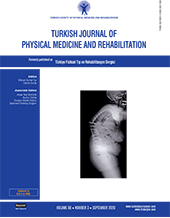Evaluation of pain, quality of life, and patient satisfaction in parenterally treated patients with postmenopausal osteoporosis
2 Department of Physical Medicine and Rehabilitation, Marmara University Faculty of Medicine, Istanbul, Turkey
3 Department of Physical Medicine and Rehabilitation, Ankara Numune Training and Research Hospital, Ankara, Turkey DOI : 10.5606/tftrd.2020.4114 Objectives: This study aims to evaluate pain, quality of life, and patient satisfaction in parenterally treated patients with postmenopausal osteoporosis (OP).
Patients and methods: Between May 2016 and January 2018, a total of 138 patients (mean age 63.78 years; range, 50 to 70 years) with postmenopausal OP were retrospectively analyzed. All patients were previously treated with denosumab (DEN) and parenteral forms of bisphosphonates such as zoledronic acid (ZOL) and ibandronate (IBN). The pain severity was evaluated using the visual analog scale (VAS) and Brief Pain Inventory-Short Form (BPI-SF). The quality of life was evaluated using the Quality of Life Questionnaire of the European Foundation for Osteoporosis (Qualeffo-41). For the evaluation of patient satisfaction, a three-item questionnaire including satisfaction with the medication, route, and frequency of administration was applied.
Results: Of the patients, 50 received DEN, 48 received ZOL, and 40 received IBN treatment. There was no significant difference in any of the pain parameters. All domains of the Qualeffo-41 were similar among the three groups. The patients in the DEN group were more satisfied with their medication (DEN: 88%, ZOL: 43.75%, and IBN: 52.5%), its administration route (DEN: 84%, ZOL: 43.8%, and IBN: 57.5%), and the frequency of its administration (DEN: 84%, ZOL: 56.25%, and IBN: 52.5%) (p=0.0001).
Conclusion: Neither of the medication showed a superior effect on quality of life. However, patients were more satisfied with medications used in a six-month interval and applied subcutaneously. Of these three treatment options, DEN seems to be a step ahead in terms of patient satisfaction.
Keywords : Osteoporosis, pain, patient satisfaction, quality of life, treatment

















